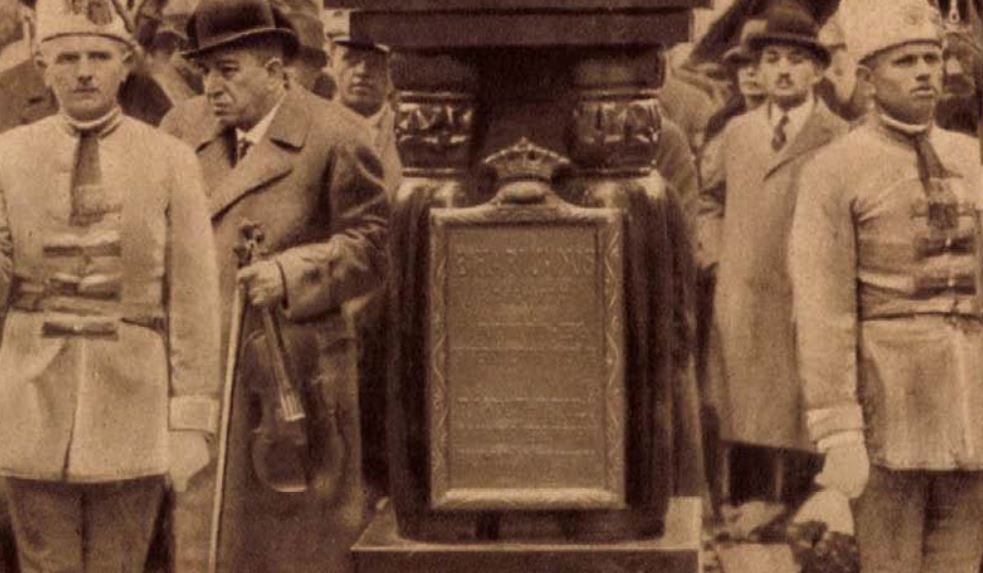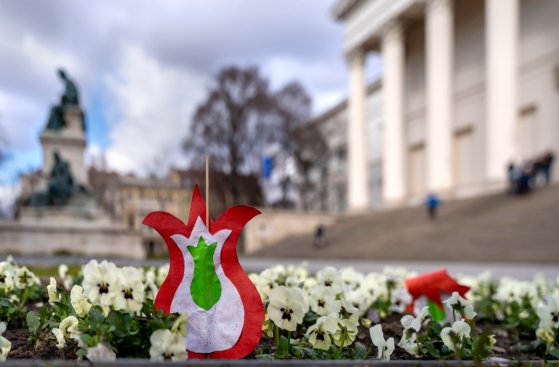Under the leafy boughs of Margit Island hides a kind of pantheon of Hungarian art: statues of painters, writers, poets, sculptors and musicians can be found in the shadow of the ancient trees of the island. Among them is the statue of a special figure of Hungarian culture and music history, the gipsy band leader János Bihari. However, Károly Radó's work, erected in 1969, is only a replacement for the original bronze bust, made for the centenary of the death of Bihari, that was destroyed during the siege of 1944-1945.
The statue of János Bihari seen today on Margit Island. The work of Károly Radó was erected in 1969 (Photo: Gergely Flier/pestbuda.hu)
The original Bihari Statue was created by László Vaszary, who was born in 1876 in Hencse, Somogy County. He lost his hearing at the age of three, so at the age of seven, he was admitted to the Vác Deaf-Mute Institute. The local principal, Ferenc Krenedits, recognized his talent, so he became a sculptor at the age of 16. He soon became a student of Alajos Strobl, and it was noted that when Franz Joseph visited Strobl's Epreskert studio, he turned with special interest to Vaszary's activities and works. His first great success was the statue of István Ferenczy in Rimaszombat (today's Rimavská Sobota, Slovakia) in 1909, which can still be seen today. Unfortunately, only a few of his works can be found in Budapest: a copy of the famous Renaissance reliefs depicting Matthias I and Queen Beatrice can be seen on the Vajdahunyadvár building and the entrance portal of the Ernst Museum. László Vaszary died in Budapest on 14 March 1944.
László Vaszary: Bust of János Bihari (Photo: Magyarország, 13 October 1928)
The model of Vaszary's sculpture on Margit Island, one of the great figures in Hungarian music history, composer and violinist János Bihari, also called "the Hungarian Orpheus" and "Gypsy King", was born in Nagyabony (today's Veľké Blahovo, Slovakia) in 1764 and died in Pest in 1827. He was a gipsy musician, a violinist. He continued a family tradition. His father already played the instrument. Bihari played in Pest from 1801, where he formed his famous band. His music garnered great acclaim. He played in Pozsony (today's Bratislava, Slovakia) during the 1811 Parliament, allegedly Ludwig van Beethoven in Vienna, and then Ferenc Liszt in Pest listened to him playing several times and remembered it with great acclaim. In the public speech, Bihari also earned the honorary title of “Gypsy Musician of Maria Theresa and Archduke Joseph”. Although his career had been declining since 1823, he was still playing in Pozsony at the time of the Queen's coronation in 1825. His name is often mentioned in connection with the Rákóczi March. He played that a lot with his band, and in fact, some considered the music officially composed by Nikolaus Scholl to be a work of Bihari.
Portrait of János Bihari from the 7 February 1875 issue of the Vasárnapi Ujság
The country commemorated the centenary of his death. On the anniversary, a mourning mass was celebrated in the parish church of Bakáts Square in Budapest, which was of great interest. A Bihari Memorial Committee was formed, which initiated the erection of a statue of the great musician. The venue was designated on Margit Island because of the memorable event when Bihari so captivated the people present at Archduke Joseph's (Palatine of Hungary) court ball with his music that the dance stopped at the ball, and guests only admired him playing the violin.
The statue of János Bihari on Margit Island stood in a clearing surrounded by weeping willows. On the left side of the picture is the sculptor László Vaszary, the creator of the statue (Photo: Ország-Világ, 11 November 1928)
László Vaszary was commissioned to create the bust, and the costs of the sculpture were borne by the Budapest Public Works Council. The statue was unveiled on Sunday, 14 October 1928, as part of a musical ceremony.
László Vaszary's great work depicted Bihari with his violin, of course, in a truly princely pose worthy of the Gypsy King, at the height of his success. Interestingly, the pedestal of the statue was not made of stone but of organic material, called pitch pine. It is a tree species native to North America, scientifically named Pinus rigida. On this wooden pedestal, a bronze plaque was placed with the inscription "János Bihari 1764-1827. The laurel-wreathed poet of Hungarian heroic music, the Rákóczi March, and the immortal musician of Hungarian verbunkos. 1928.”
The statue of János Bihari was unveiled on Margit Island in a ceremonial setting (Photo: Tolnai Világlapja, 24 October 1928)
The plaque was adorned with a crown at the top, a hedgehog underneath, with an oak branch in its mouth. Few people know it, but the hedgehog was a symbol of the Gypsies, and the hedgehog holding an oak branch in its mouth was specifically of the Hungarian Gypsies. This motif was also included on the cover of the first edition of the gipsy grammar book, a classic work of Gypsy science by Archduke Joseph Karl of Habsburg-Lorraine (1833-1905).

The hedgehog as a symbol of Gypsies on the title page of the first edition of the Gypsy grammar book of Archduke Joseph Karl (Photo: Központi Antikvárium)
The statue did not stand where Bihari's present bust is today, near St. Michael's Church, on the Promenade of Hungarian Artists. The original statue was erected on a “clearing surrounded by weeping willows,” in the southern part of the island, near the former Kastély Restaurant.
The unveiling ceremony of the Bihari statue was attended by Archduke Joseph – Joseph August of Habsburg-Lorraine (1872-1962) – but the famous Gypsy musicians from Pest and the still-living descendants of János Bihari also took part. The ceremony began with the Rákóczi March, and many other Bihari-related pieces of music were performed by the descendants of the gipsy musician. József Zseny and Gyula Pékár, representing the Bihar Memorial Committee, made speeches. Iván Rakovszky then accepted the statue on behalf of the Public Works Council. Among the musicians around the new statue, the contemporary press reports highlight the names Béla Radics, Laci Rácz, Nándor Sovánka and Pepi Purcsi.
Láci Rácz, a gypsy band leader places a wreath at the statue of János Bihari on Margit Island (Photo: Ország-Világ, 11 November 1928)
Just over a decade and a half was given to the statue, as it was swept away by the siege at the end of World War II. But the celebration of the sculpture erection in 1928 was a great moment for old Hungary when gipsy music was played around the statue of János Bihari on Margit Island... And if we are looking for relief under the trees of Margit Island here from the heat of summer, let us remember the "Hungarian Orpheus", the "Gypsy King", whose art was once admired by the distinguished guests of the ball of Archduke Joseph.
Cover photo: Memorial plaque on the pedestal of the statue of János Bihari on Margit Island (Photo: Tolnai Világlapja, 24 October 1928)





































Hozzászólások
Log in or register to comment!
Login Registration